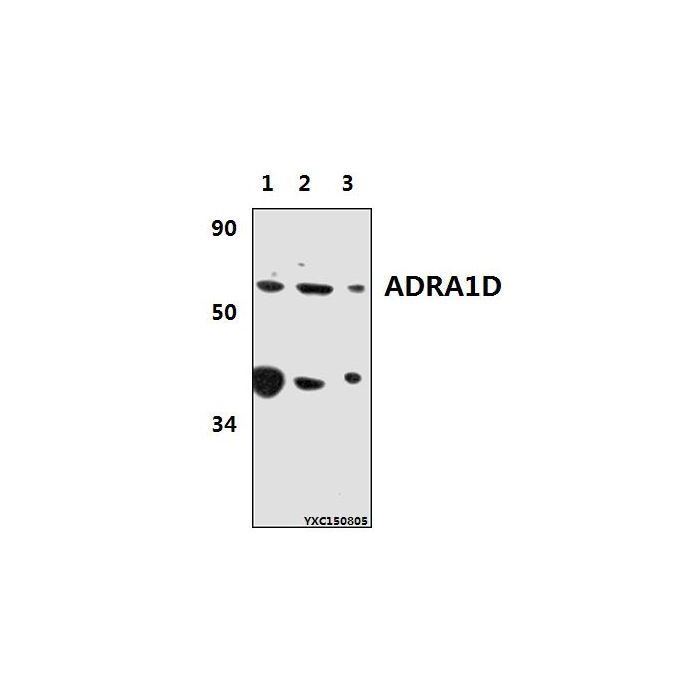ADRA1D polyclonal, anti-human, mouse, rat
€305.00
In stock
SKU
BS61380
Background:
α1D-adrenergicreceptors(α1D-ARs)couple to Gq/11 and participate directly in sympatheticregulation ofsystemic blood pressure byvasoconstriction. α1D-AR can form hetero-oligomers with α1B receptors. α1D-AR transcripts are abundant in prostate and aorta. α1A adrenergicreceptors(α1A-ARs) mediate actionsin the sympathetic nervoussystem through the binding of the catecholamines, epinephrine and norepinephrine. α1A-adrenergic receptors couple to Gq/11 and regulate blood pressure due to changesin vascular tone and cardiac output. Alternative splicing of this gene generatesfour isoforms with distinct C-termini, and the different expression profile of these subtypes produces distinct patterns of activation. α1A-AR transcripts are abundant in heart, brain, liver, and prostate. α1A-AR transcriptsizes of 6.0, 4.0, 3.0, and 2.0 kb have been detected in liver. α1A-AR transcriptsizes of 6.0, 4.0 and 3.0 kb transcripts have been detected in heart, and 6.0 kb and 4.0 kb transcripts have been detected in prostate.
Alternative Name:
Alpha-1D adrenergic receptor, Alpha-1A adrenergic receptor, Alpha-1D adrenoreceptor, Alpha-1D adrenoceptor, Alpha-adrenergic receptor 1a, ADRA1D, ADRA1A
Application Dilution: WB: 1:500~1:1000, IHC: 1:50~1:200
Specificity: ADRA1D polyclonal antibody detects endogenous levels of ADRA1D protein.
Immunogen:
Synthetic peptide, corresponding to amino acids456-501 of Human ADRA1D
MW: ~ 60 kDa
Swis Prot.: P25100
Purification & Purity:
The antibody was affinity-purified from rabbit antiserum by affinity-chromatography using epitope-specific immunogen and the purity is > 95% (by SDS-PAGE).
Format:
1 mg/ml in Phosphate buffered saline (PBS) with 0.05% sodium azide, approx. pH 7.3.
Storage:
Store at 4°C short term. Aliquot and store at -20°C long term. Avoid freeze-thaw cycles.
For research use only, not for use in diagnostic procedure.
α1D-adrenergicreceptors(α1D-ARs)couple to Gq/11 and participate directly in sympatheticregulation ofsystemic blood pressure byvasoconstriction. α1D-AR can form hetero-oligomers with α1B receptors. α1D-AR transcripts are abundant in prostate and aorta. α1A adrenergicreceptors(α1A-ARs) mediate actionsin the sympathetic nervoussystem through the binding of the catecholamines, epinephrine and norepinephrine. α1A-adrenergic receptors couple to Gq/11 and regulate blood pressure due to changesin vascular tone and cardiac output. Alternative splicing of this gene generatesfour isoforms with distinct C-termini, and the different expression profile of these subtypes produces distinct patterns of activation. α1A-AR transcripts are abundant in heart, brain, liver, and prostate. α1A-AR transcriptsizes of 6.0, 4.0, 3.0, and 2.0 kb have been detected in liver. α1A-AR transcriptsizes of 6.0, 4.0 and 3.0 kb transcripts have been detected in heart, and 6.0 kb and 4.0 kb transcripts have been detected in prostate.
Alternative Name:
Alpha-1D adrenergic receptor, Alpha-1A adrenergic receptor, Alpha-1D adrenoreceptor, Alpha-1D adrenoceptor, Alpha-adrenergic receptor 1a, ADRA1D, ADRA1A
Application Dilution: WB: 1:500~1:1000, IHC: 1:50~1:200
Specificity: ADRA1D polyclonal antibody detects endogenous levels of ADRA1D protein.
Immunogen:
Synthetic peptide, corresponding to amino acids456-501 of Human ADRA1D
MW: ~ 60 kDa
Swis Prot.: P25100
Purification & Purity:
The antibody was affinity-purified from rabbit antiserum by affinity-chromatography using epitope-specific immunogen and the purity is > 95% (by SDS-PAGE).
Format:
1 mg/ml in Phosphate buffered saline (PBS) with 0.05% sodium azide, approx. pH 7.3.
Storage:
Store at 4°C short term. Aliquot and store at -20°C long term. Avoid freeze-thaw cycles.
For research use only, not for use in diagnostic procedure.
| Is Featured? | No |
|---|
Write Your Own Review

